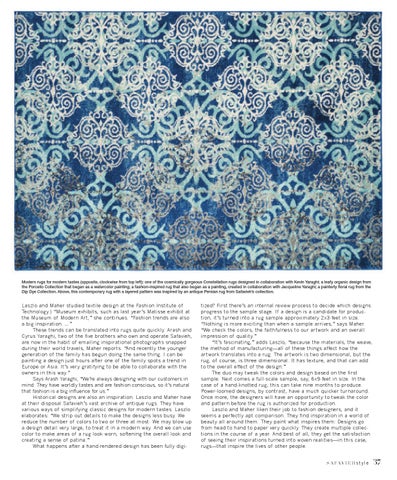Modern rugs for modern tastes (opposite, clockwise from top left): one of the cosmically gorgeous Constellation rugs designed in collaboration with Kevin Yaraghi; a leafy organic design from the Porcello Collection that began as a watercolor painting; a fashion-inspired rug that also began as a painting, created in collaboration with Jacqueline Yaraghi; a painterly floral rug from the Dip Dye Collection. Above, this contemporary rug with a layered pattern was inspired by an antique Persian rug from Safavieh’s collection.
Laszlo and Maher studied textile design at the Fashion Institute of Technology.) “Museum exhibits, such as last year’s Matisse exhibit at the Museum of Modern Art,” she continues. “Fashion trends are also a big inspiration. …” These trends can be translated into rugs quite quickly. Arash and Cyrus Yaraghi, two of the five brothers who own and operate Safavieh, are now in the habit of emailing inspirational photographs snapped during their world travels, Maher reports. “And recently the younger generation of the family has begun doing the same thing. I can be painting a design just hours after one of the family spots a trend in Europe or Asia. It’s very gratifying to be able to collaborate with the owners in this way.” Says Arash Yaraghi, “We’re always designing with our customers in mind. They have worldly tastes and are fashion conscious, so it’s natural that fashion is a big influence for us.” Historical designs are also an inspiration. Laszlo and Maher have at their disposal Safavieh’s vast archive of antique rugs. They have various ways of simplifying classic designs for modern tastes. Laszlo elaborates: “We strip out details to make the designs less busy. We reduce the number of colors to two or three at most. We may blow up a design detail very large, to treat it in a modern way. And we can use color to make areas of a rug look worn, softening the overall look and creating a sense of patina.” What happens after a hand-rendered design has been fully digi-
tized? First there’s an internal review process to decide which designs progress to the sample stage. If a design is a candidate for production, it’s turned into a rug sample approximately 2x3-feet in size. “Nothing is more exciting than when a sample arrives,” says Maher. “We check the colors, the faithfulness to our artwork and an overall impression of quality.” “It’s fascinating,” adds Laszlo, “because the materials, the weave, the method of manufacturing—all of these things affect how the artwork translates into a rug. The artwork is two dimensional, but the rug, of course, is three dimensional. It has texture, and that can add to the overall effect of the design.” The duo may tweak the colors and design based on the first sample. Next comes a full-scale sample, say, 6x9-feet in size. In the case of a hand-knotted rug, this can take nine months to produce. Power-loomed designs, by contrast, have a much quicker turnaround. Once more, the designers will have an opportunity to tweak the color and pattern before the rug is authorized for production. Laszlo and Maher liken their job to fashion designers, and it seems a perfectly apt comparison. They find inspiration in a world of beauty all around them. They paint what inspires them: Designs go from head to hand to paper very quickly. They create multiple collections in the course of a year. And best of all, they get the satisfaction of seeing their inspirations turned into woven realities—in this case, rugs—that inspire the lives of other people. S A FA V I E H s t y l e
SAF.fw15.Rugs.indd 37
37
9/23/15 11:58 AM
